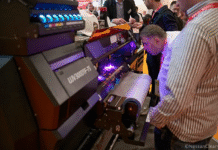Mimaki exhibited the CJV330, which is one of the latest models in its eco-solvent printing series, at the Media Expo in Greater Noida. It also showcased three 100 series models – the JV100, UJV100, and TS100 inkjet printers at the recent in-person Media Expo New Delhi 2022. The JV100 uses eco-solvent inks, the UJV100 uses UV cured inks and the TS100 is a dye-sublimation model using transfer papers.
Also displayed was the Mimaki UJF-6042MkIIe flatbed UV printer. Mimaki displayed a laser cutting system to show the combination of UV curing, printing, and laser cutting as a core set or combination of tools to cover multiple applications or end products. Kenichiro (Ken) Seki, managing director, Mimaki said, “There are many, many laser cutter users in the market, but what the laser cannot do is to make color, which we can add color by using the UJF. This combination adds value to the laser cutting machine users.”
Expanding the market by stretching in both directions
“The market itself is of bigger volume in the lower-end segments. In the high-end section, customers require very high-speed printing. Mimaki usually caters to the middle segment, which is not so expensive and doesn’t require super high printing and image quality. Now we are going to target the high-end segment as well in India. We haven’t started yet but in Japan, we now have the JFX600, which is our high-end model for UV flatbed printing. Eventually, we want to introduce that kind of high-end machine in India so that we can target those higher-end customers and at the same time, use the 100 series machines to target the low-end customers as well. I am not thinking that we can take all those customers but we want to maybe stretch to reach those lower-end customers as well because they are dominated by Chinese or local Indian companies. We will have to expand our market volume so we have both the high-end and low-end customers,” he added.
3D printing with full color
Mimaki had earlier launched the 3DUJ-553 color 3D printer, enabling the full-color modeling of over 10 million colors. About the printer, Seki said, “The machine is already in the market but we haven’t started selling it in India yet. We have to be ready because 3D printing is a totally different mindset and technology. We have to learn a lot more and maybe hire someone, especially for this segment. We still don’t know about the market size of 3D printing. India itself is a big country, so eventually, we will start but we haven’t finalized when.”
About the Media Expo New Delhi 2022 in Greater Noida, he said, “The location is far from Delhi and that’s also a good thing because only genuine customers are visiting. And that’s why we are receiving quite a good number of quality leads. Overall, I think it’s a very good event.”
Signing off, Seki added, “We will announce new applications and new models soon so keep an eye on that.”
















